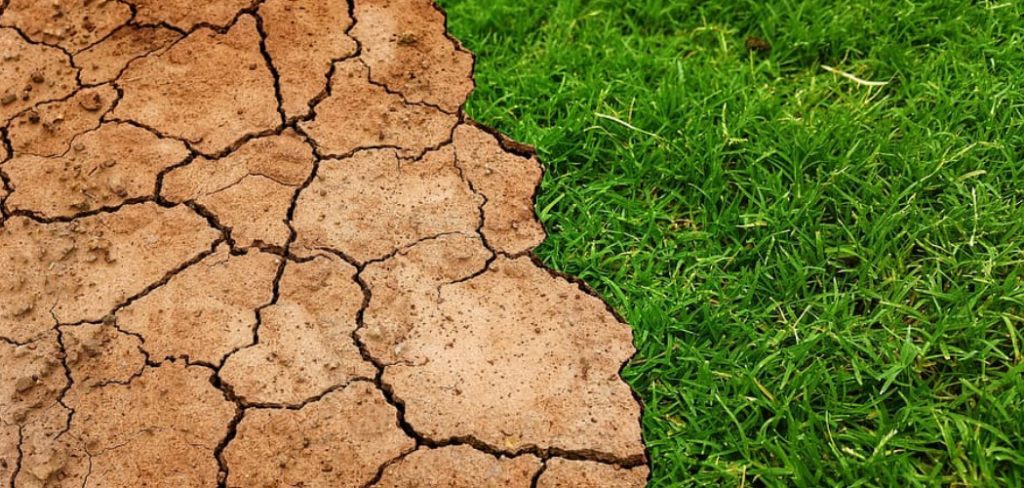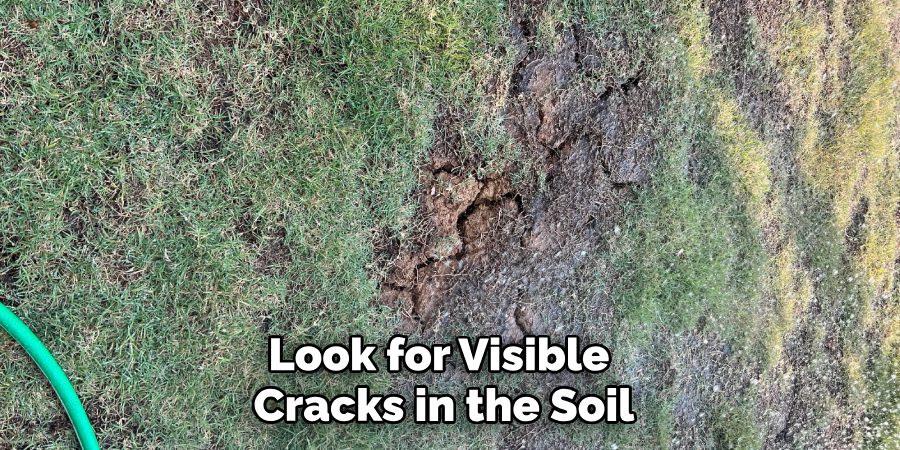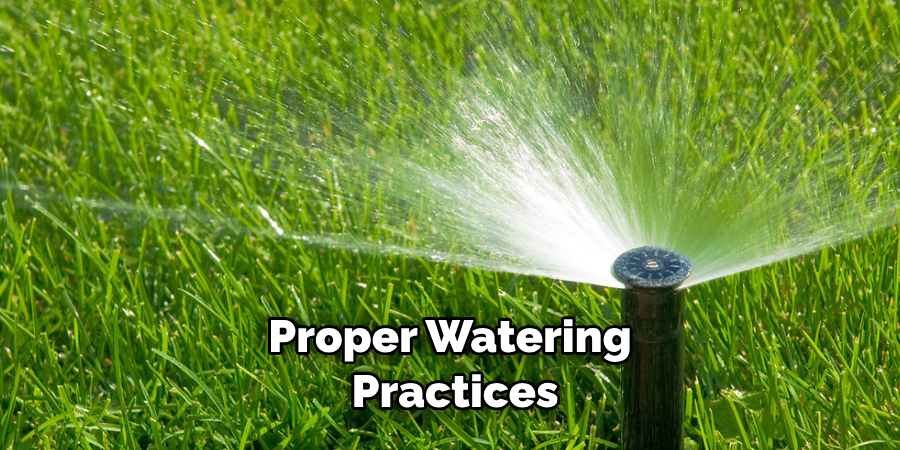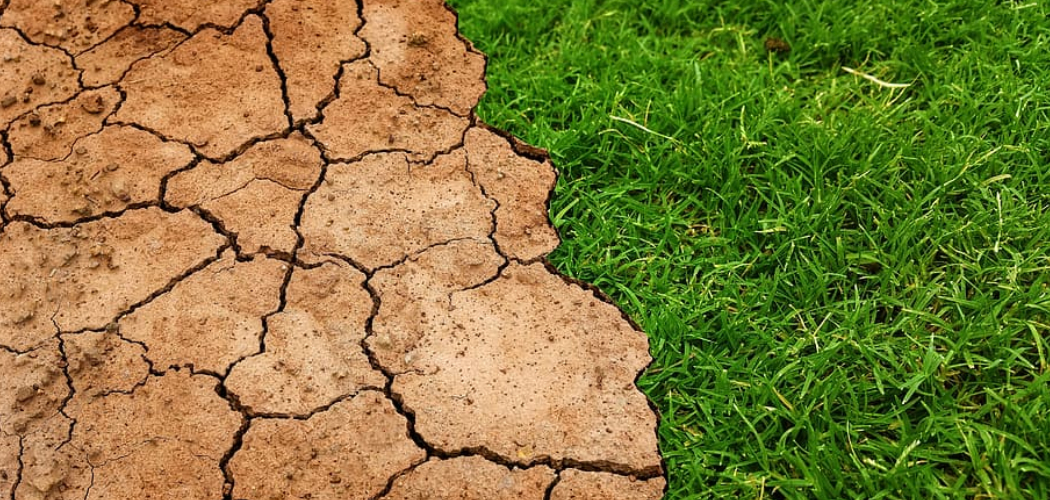To get rid of cracks in your lawn, fill them with a mixture of topsoil and sand, then water and compact the area. A cracked lawn can be an eyesore and a tripping hazard.
Whether caused by dry weather conditions or soil settling, it’s important to address this issue to maintain a lush, healthy lawn. In this article, we will provide you with effective and straightforward methods to get rid of cracks in your lawn.
By following these steps, you can restore the beauty of your yard and create a safe and inviting outdoor space for your family and friends to enjoy. Let’s dive right in and discover how to tackle this common lawn problem.

Reasons For Cracks In Lawn
Cracks in lawns are a common issue that can be resolved by addressing their root causes. Dry and drought conditions are one of the main culprits behind these cracks. Insufficient moisture in the soil leads to its shrinkage and the formation of cracks.
Soil compaction is another significant factor. When the soil becomes compacted, it prevents water from penetrating and reaching the roots, resulting in cracks. Excessive thatch buildup also contributes to the problem. Thatch is a layer of dead organic material between the grass blades and soil.
If it accumulates too much, it can disrupt water absorption and cause cracks. By addressing these underlying causes, such as improving irrigation practices, decompacting the soil, and regularly removing thatch, you can effectively get rid of cracks in your lawn.
How To Identify Cracks In Lawn
Identifying cracks in your lawn is crucial to addressing the issue effectively. Look for visible cracks in the soil, which are often a sign of underlying problems. Also, pay attention to an uneven surface as it can indicate the presence of cracks.

In addition, observe how water drains or pools on your lawn. Uneven or erratic water pooling can be a symptom of cracks. To get rid of these cracks, carefully examine the affected area and determine the cause. It could be due to soil compaction, excessive foot traffic, or poor drainage.
Once you’ve identified the cause, implement the necessary solutions. Consider aerating the soil, reducing foot traffic, and improving drainage to prevent future cracks. By addressing the issue promptly, you can restore your lawn’s health and appearance.
How to Get Rid of Cracks in Lawn: Step by Step Guide
Techniques To Repair Cracks In Lawn
Repairing cracks in your lawn is crucial for maintaining its healthy appearance and preventing further damage. To start, practice proper watering techniques, ensuring your lawn receives adequate moisture without overwatering. Aeration and dethatching are also essential steps in repairing cracks.
These processes help loosen compacted soil and remove dead organic matter, allowing for better water infiltration. Additionally, consider topdressing your lawn with a layer of compost or topsoil. This will help level out any uneven surfaces and provide essential nutrients for growth.
Lastly, overseeding the affected areas will help fill in the cracks and promote new grass growth. By following these techniques, you can effectively repair cracks in your lawn and restore its lush, green beauty.
Proper Watering Practices
Proper watering practices are key to getting rid of cracks in your lawn. Deep and infrequent watering is important because it encourages the roots to grow deeper, making them more resilient to drought and reducing the likelihood of cracks. Watering in the morning is also crucial as it allows the grass to dry out during the day, preventing the growth of diseases and fungi.

Avoid overwatering, as this can lead to shallow root growth and make the lawn more susceptible to cracking. Remember to water the lawn only when it needs it, based on the weather conditions and the moisture level of the soil.
By following these watering practices, you can keep your lawn healthy and free from cracks.
Aeration And Dethatching
Aeration and dethatching are two essential processes for getting rid of cracks in your lawn. Core aeration involves the use of a machine to remove small cores of soil from the lawn, allowing air, water, and nutrients to penetrate deeper.
Mechanical dethatching, on the other hand, involves using a dethatching machine to remove built-up layers of dead grass and debris from the top layer of the lawn. Both these processes have several benefits. By aerating the lawn, you can improve the root system, enhance water and nutrient absorption, and promote overall healthier and greener grass.
Meanwhile, dethatching helps to prevent thatch build-up, improve air circulation, and create a better environment for new growth. So, if you want to get rid of cracks in your lawn, make sure to incorporate aeration and dethatching into your lawn care routine.
Topdressing And Overseeding
Topdressing and overseeding are effective techniques for getting rid of cracks in your lawn. By applying organic matter, you can improve the soil’s structure and fertility. One crucial step is choosing the right grass seed that matches your lawn’s conditions.
This ensures proper growth and resilience. Another important aspect is ensuring proper seed to soil contact, allowing the seeds to establish successfully. These methods work wonders in transforming your lawn into a healthy and vibrant space. Implement these strategies and bid farewell to those unsightly cracks, as your lawn flourishes with lush greenery.
Rediscover the joy of having a beautiful and crack-free lawn that enhances the overall appeal of your outdoor space.
Preventing Cracks In Lawn
Preventing cracks in your lawn requires regular maintenance, soil testing, amendments, and proper care techniques. Regular maintenance is essential to keep your lawn healthy and free from cracks. Soil testing helps identify any nutrient deficiencies and allows for the necessary amendments to be made.

By addressing these deficiencies, you can create a better environment for grass growth, reducing the likelihood of cracks. Additionally, following proper lawn care techniques, such as mowing at the appropriate height, watering deeply but infrequently, and aerating the soil, can help prevent cracks from forming.
By taking these steps, you can keep your lawn lush, green, and crack-free throughout the year.
Regular Lawn Maintenance
Regular lawn maintenance plays a crucial role in getting rid of cracks in the lawn. Mowing at the correct height is essential to maintain a healthy lawn and prevent the growth of weeds and invasive plants. Avoid starting the sentences with repetitive terms and focus on unique phrases.

Removing weeds and invasive plants is another important aspect of lawn maintenance that helps in reducing cracks. Regular fertilization and weed control also contribute to keeping the lawn in good condition. By following these practices and ensuring proper lawn maintenance, you can effectively eliminate cracks and maintain a beautiful and healthy lawn.
Soil Testing And Amendments
Soil testing is crucial to identify nutrient deficiencies in your lawn. Adjusting ph levels can also help prevent cracks from forming. Adding organic matter like compost or mulch enhances soil structure and encourages root growth. By testing for nutrient deficiencies, you can address any imbalances in nitrogen, phosphorus, or potassium.
Adjusting ph levels involves adding lime to raise the ph or sulfur to lower it, depending on your soil’s needs. Adding organic matter improves soil fertility, moisture retention, and overall health. These practices promote a strong and healthy lawn, reducing the chances of cracks forming.
Regular soil testing and amendments are key to maintaining a vibrant and crack-free lawn.
Frequently Asked Questions For How To Get Rid Of Cracks In Lawn
How Do Cracks Form In A Lawn?
Cracks in a lawn can form due to various reasons such as soil compaction, lack of water, excessive heat, or freezing temperatures. These factors cause the soil to shrink and expand, leading to cracks on the surface.
Can Cracks In A Lawn Affect Its Health?
Yes, cracks in a lawn can affect its health. They hinder proper water penetration, result in poor nutrient absorption, and make it harder for grass roots to establish themselves. Additionally, weeds can take advantage of the cracks and compete with the grass for resources, further impacting the lawn’s health.
Is It Necessary To Fix Cracks In A Lawn?
Fixing cracks in a lawn is beneficial for its overall health and appearance. By filling the cracks, you improve water retention, nutrient absorption, and provide a level surface for the grass to grow. Regular maintenance of cracks helps prevent further damage and ensures a healthy, lush lawn.
How Can I Repair Cracks In My Lawn?
To repair cracks in your lawn, start by removing any debris or loose soil from the crack. Use a lawn patching compound or topsoil mixed with grass seed to fill the crack, ensuring it is level with the surrounding area.
Water the repaired area regularly and monitor for proper grass growth.
Can I Prevent Cracks From Forming In My Lawn?
While it may be difficult to completely prevent cracks from forming in your lawn, there are steps you can take to minimize their occurrence. Regularly aerating the soil, reducing foot traffic, maintaining optimal watering and fertilization, and avoiding excessive mowing heights can all help in preventing or reducing the formation of cracks.
How Often Should I Check And Repair Cracks In My Lawn?
It is recommended to check and repair cracks in your lawn at least twice a year, typically during spring and fall. However, if you notice new cracks forming or existing cracks worsening, it is advisable to address them promptly to prevent further damage and maintain a healthy lawn.
Conclusion
In a nutshell, addressing cracks in your lawn requires a proactive approach and consistent maintenance. By understanding the causes behind the cracks, such as soil compaction and improper watering, you can implement effective strategies to prevent and repair them. Regularly aerating your lawn, improving drainage, and ensuring proper irrigation are key steps to maintaining a healthy and crack-free lawn.
Additionally, regularly inspecting and repairing any damage, such as uneven terrain or tree roots, can prevent cracks from forming. It is also essential to choose the right type of grass that is suitable for your climate and soil conditions. By implementing these strategies and taking proper care of your lawn, you can effectively get rid of cracks and achieve a lush, pristine landscape to enjoy for years to come.

